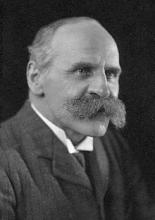British physiologist and philosopher John Scott Haldane was born on 3 May 1860 in Edinburgh, Scotland, fourth son of Robert Haldane by his second wife, Mary Elizabeth. His father was Writer to the Signet of Cloanden (later called Cloan), in Auchterarder, Perthshire.
Haldane was educated at Edinburgh Academy, Edinburgh University and the University of Jena in Germany. Graduating in medicine at Edinburgh University in 1884, he was appointed Demonstrator in Physiology at University College, Dundee, where he investigated the composition of the air in dwellings and schools. In 1887 he moved to Oxford, England, joined his uncle, John Burdon-Sanderson, who was Waynflete Professor of Physiology, as a demonstrator. Haldane studied the suffocative gases occurring in coal mines and wells, exposing their dependence on spontaneous oxidation processes that could take place in the coal and soil. Further work shed light on the physiological action of carbon monoxide, and in due course he submitted an important report to the Home Secretary in 1896, showing the causes of death in colliery explosions and underground fires. Haldane’s work formed a basis on which to develop measures to prevent the danger. As a result of his research he became associated with the mining profession, an association he maintained his whole life. His researches into mining problems continued.
In 1891 Haldane married Louisa Kathleen. They had a son, John Burdon Sanderson Haldane, who became a Fellow of the Royal Society (FRS) and Weldon Professor of Biometry at University College, London, and a daughter, the novelist. Naomi Mary Margaret Mitchison.
Between 1892 and 1900, Haldane introduced new methods both for investigating the physiology of the respiration and blood and also for gas analysis. Among his inventions, the haemoglobinometer, the apparatus for blood-gas analysis, and the one for the accurate and fast analysis of air or mixtures of gases were the most widely in use.
In 1901 Haldane was elected a Fellow of New College, Oxford. His paper on the regulation of lung ventilation, developed in collaboration with John Gillies Priestley, was published in the Journal of Physiology in 1905. In his continuing research in pure physiology, Haldane investigated the impacts of oxygen deficiency and muscular exercise on breathing.
From 1907 to 1913 Haldane was Reader in Physiology at Oxford. Four years later he led a scientific expedition to Pike’s Peak in Colorado, in order to study the effects of low barometric pressure and the acclimatization of the human body to high altitudes. His discoveries revolutionized current ideas about respiration.
Through his physiological research, Haldane was from 1896 an invaluable member of many committees advising different departments of the government. Among others he investigated the problem of deep diving for the Admiralty, which led to his development of the detailed method of ‘stage decompression’, a method that abolished the risks of caisson disease.
In 1912 Haldane became Director of the Mining Research Laboratory founded at Bentley Colliery near Doncaster. In 1921 he became a member of the Safety in Mines Research Board and Honorary Professor of mining at Birmingham University, and in 1924 was elected President of the Institution of Mining Engineers. He remained in this position until 1928.
During the First World War he identified for the War Office the type of poison gas introduced by the Germans and its effects. He designed a portable oxygen administration apparatus for use in the field. His book Respiration was first published in 1922 and was based on the Silliman Memorial Lectures delivered in Yale University in 1916.
Haldane’s philosophical views were mainly developed in the last two decades of his life. He was appointed Gifford Lecturer at the University of Glasgow for 1927 and 1928. These lectures were published in the book The Sciences and Philosophy in 1929. Further works on philosophy are The Philosophical Basis of Biology (1931), founded on the Donnellan Lectures delivered at Dublin University in 1930, and The Philosophy of a Biologist (1935).
Beside honorary degrees from many universities, John Scott Haldane was elected Fellow of the Royal Society (FRS) in 1897, a Royal Medallist of the society in 1916, Copley Medallist in 1934, and in 1928 he was appointed Companion of Honour for his scientific work in connexion with industrial disease.
Haldane died in Oxford at midnight 14/15 March 1936, shortly after returning from a visit to Persia, where he had been investigating cases of heat stroke in the oil refineries.



